
This is a template used to create a lesson surrounding an NGSS PE (5-PS1-1)
- Subject:
- Physical Science
- Material Type:
- Lesson
- Date Added:
- 06/20/2018

This is a template used to create a lesson surrounding an NGSS PE (5-PS1-1)

This is a lesson within a unit around structure and properties of matter using PE 5-PS1-2.
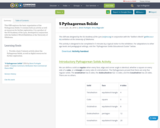
This OER explores the basic organization of the Pythagorean Solids. It contains both an activity as well as resources for further exploration. It is a product of the OU Academy of the Lynx, developed in conjunction with the Galileo's World Exhibition at the University of Oklahoma.
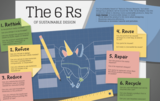
This lesson is designed as a supplement or extension to the 5th grade Smithsonian Science for the Classroom module titled How Can We Provide Freshwater to Those in Need? This lesson can be taught as an extension following Lesson 2: WATER FOOTPRINT. This lesson is designed to facilitate student learning about sustainable design and green chemistry principles.

This lesson is designed as a supplement or extension to the 5th grade Smithsonian Science for the Classroom module titled How Can We Identify Materials Based on Their Properties? This lesson can be taught as an extension following Lesson 3: PLANT PRODUCTS or Lesson 6: CHEMISTS MAKE SOLUTIONS.This lesson is designed to facilitate student learning about sustainable design and green chemistry principles.
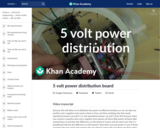
In this video we hack apart a bread board to create a 5 volt power distribution strip. The 5 volts comes from the center pin in the motor controller and the negative or ground comes from the ground pin on the motor controller. Created by Karl Wendt.

6.5 Nerves, Hormones & Homeostasis | i-Biologyi-biology.net/ibdpbio/06-human-health.../nerves-hormones-homeostasis/Cached
SimilarEssential Biology 6.5 Nerves, Hormones and Homeostasis .........o0O0o. ... Tutorial and game from think-bank ..... Online Learning ... Creative Commons License
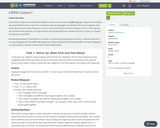
In this lesson, students use collections of objects to make sense of and use ratio language. Students see that there are several different ways to describe a situation using ratio language. For example, if we have 12 squares and 4 circles, we can say the ratio of squares to circles is 12:4 and the ratio of circles to squares is 4 to 12. We may also see a structure that prompts us to regroup them and say that there are 6 squares for every 2 circles, or 3 squares for every one circle (MP7).Expressing associations of quantities in a context—as students will be doing in this lesson—requires students to use ratio language with care (MP6). Making groups of physical objects that correspond with “for every” language is a concrete way for students to make sense of the problem (MP1).

Researching different cultures in the Eastern and Western Hemisphere.
6.3.3 Describe and compare major physical characteristics of regions in Europe and the Americas.
6.3.4 Describe and compare major cultural characteristics of regions in Europe and the Western Hemisphere.
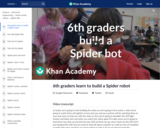
Vicki Lombardi's 6th grade students at Santa Rita Elementary in Los Altos School district learn how to build a Spider robot. Read more at: http://lasdilearn.blogspot.com/2013/02/third-graders-building-robots-mission.html. Created by Karl Wendt.

In this course, you will learn the principles of genetics with application to the study of biological function at the level of molecules, cells, and multicellular organisms, including humans. We will cover structure and function of genes, chromosomes, and genomes; biological variation resulting from recombination, mutation, and selection; population genetics; and the use of genetic methods to modify genes and genomes and analyze protein function, gene regulation, and inherited disease.
This course, based on the MIT course 7.03 Genetics taken by enrolled MIT students, was organized as a three-part series on edX by MIT’s Department of Biology (Note: The third part of the course is not available yet). It is self-paced and free as long as you enroll in the Audit Track option, which you can select after creating a free account on edX.

In this course, you will engage in the biology of cells of higher organisms. You will study the structure, function, and biosynthesis of cellular membranes and organelles; cell growth and oncogenic transformation; transport, receptors, and cell signaling; the cytoskeleton, the extracellular matrix, and cell movements; cell division and cell cycle; functions of specialized cell types. This course emphasizes the current molecular knowledge of cell biological processes as well as the genetic, biochemical, and other experimental approaches that resulted in these discoveries.
This course, based on the MIT course 7.06 Cell Biology taken by enrolled MIT students, was organized as a three-part series on edX by MIT’s Department of Biology. It is self-paced and free as long as you enroll in the Audit Track option, which you can select after creating a free account on edX.

This course is an in-depth adventure through the molecular mechanisms that control the maintenance, expression, and evolution of prokaryotic and eukaryotic genomes. Through lectures and readings of relevant literature, students will explore gene regulation, DNA replication, genetic recombination, transcription, and mRNA translation. The quizzes are designed to build students’ experimental design and data analysis skills.
This course, based on the MIT course 7.28/7.58 Molecular Biology taken by enrolled MIT students, was organized as a three-part series on edX by MIT’s Department of Biology. It is self-paced and free as long as you enroll in the Audit Track option, which you can select after creating a free account on edX.

In this 21-day unit, students are introduced to the anchoring phenomenon—a flameless heater in a Meal, Ready-to-Eat (MRE) that provides hot food to people by just adding water. Students explore the inside of an MRE flameless heater, then do investigations to collect evidence to support the idea that this heater and another type of flameless heater are undergoing chemical reactions as they get warm. Students have an opportunity to reflect on the engineering design process, defining stakeholders, and refining the criteria and constraints for the design solution.
This unit is part of the OpenSciEd core instructional materials for middle school.

These lesson plans and activities were developed by Janine Darragh, Gina Petrie, and Stan Pichinevskiy and were previously located on the Reaching for English app. Created for K-12 English teachers in Nicaragua, the materials may be used and adapted for any country's specific context and needs.
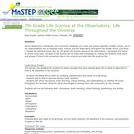
This classroom activity will show students that there is a lot we don't know about science, for example life throughout the universe. It will hopefully encourage students to question what we know and don't know, and exploration and study of the unknown.
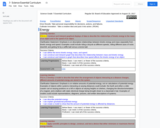
7th Grade Regular Science Scope & Sequence

Oh, no! I’ve dropped my phone! Most of us have experienced the panic of watching our phones slip out of our hands and fall to the floor. We’ve experienced the relief of picking up an undamaged phone and the frustration of the shattered screen. This common experience anchors learning in the Contact Forces unit as students explore a variety of phenomena to figure out, “Why do things sometimes get damaged when they hit each other?”
Student questions about the factors that result in a shattered cell phone screen lead them to investigate what is really happening to any object during a collision. They make their thinking visible with free-body diagrams, mathematical models, and system models to explain the effects of relative forces, mass, speed, and energy in collisions. Students then use what they have learned about collisions to engineer something that will protect a fragile object from damage in a collision. They investigate which materials to use, gather design input from stakeholders to refine the criteria and constraints, develop micro and macro models of how their solution is working, and optimize their solution based on data from investigations. Finally, students apply what they have learned from the investigation and design to a related design problem.

This unit launches with a slow-motion video of a speaker as it plays music. Students dissect speakers to explore the inner workings, and engineer homemade cup speakers to manipulate the parts of the speaker. They identify that most speakers have the same parts–a magnet, a coil of wire, and a membrane. Students investigate each of these parts to figure out how they work together in the speaker system.

This unit launches with a slow-motion video of a speaker as it plays music. In the previous unit, students developed a model of sound. This unit allows students to investigate the cause of a speaker’s vibration in addition to the effect.
Students dissect speakers to explore the inner workings, and engineer homemade cup speakers to manipulate the parts of the speaker. They identify that most speakers have the same parts–a magnet, a coil of wire, and a membrane. Students investigate each of these parts to figure out how they work together in the speaker system. Along the way, students manipulate the components (e.g. changing the strength of the magnet, number of coils, direction of current) to see how this technology can be modified and applied to a variety of contexts, like MagLev trains, junkyard magnets, and electric motors.